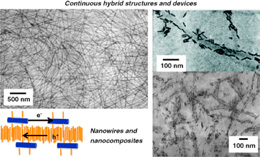ナノスケール集合による拡張連続構造体およびハイブリッド材料
Nanoscale assembly into extended and continuous structures and hybrid materials
2013年3月22日 NPG Asia Materials 5, e3 (2013) doi:10.1038/am.2012.73
自己集合: 高次構造

ポリマーという言葉からは普通、「プラスチック」が思い浮かぶが、共役ポリマーや芳香族分子を集合させた階層的ハイブリッド構造体もまた、電子デバイスや医療デバイス用として魅力的なポリマー材料である。マサチューセッツ大学(米国)のEmily PentzerとTodd Emrickは今回、特定の分子構成要素の合成における最近の進歩、それらの構成要素を集合させることによる複雑構造体の形成、そうした構造体の配列に起因する特性について概説している。自己集合法の説明では、ナノワイヤーや凝集してリボンを形成する繊維、量子ドットを持つ複合材料などを例に挙げて、共役ポリチオフェン鎖を利用した集合体形成の多様さが示されているが、これらの高次構造体は、特に半導体や光起電力応用に有用なさまざまな電子物性を示す。自己集合法の可能性を示す他の例として、ナノチューブの形成や芳香族分子からのグラフェンフレークの合成も挙げられており、PentzerとEmrickはさらに、得られた構造の制御やその安定性、集積化によるデバイス形成に関する残された課題についても取り上げている。
Self-assembly: Higher-order architecture
When polymers are mentioned, it is ‘plastics’ that typically spring to mind. Yet the assembly of conjugated polymers or aromatic molecules into hierarchical and hybrid structures also brings about materials that are attractive for electronic and medical devices. Emily Pentzer and Todd Emrick from the University of Massachusetts review recent advances into the preparation of well-defined molecular building blocks, their assembly into complex architectures, and the properties emerging from these arrangements. This approach is illustrated by the variety of assemblies featuring conjugated polythiophene chains, such as nanowires, fibrils that can further aggregate into ribbons, or composites with quantum dots. These higher-order structures display a variety of electronic properties, useful in semiconductor and photovoltaic applications among others. Another example of the potential of this approach is the construction of carbon nanotubes or graphene flakes from aromatic molecules. Pentzer and Emrick also highlight the remaining challenges that relate to controlling the structures obtained, their stability, and their integration into devices.

